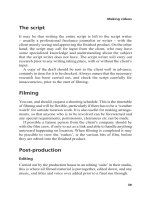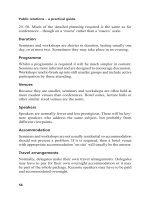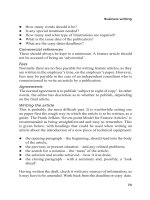Greer the long descent; a users guide to the end of the industrial age (2008)
Bạn đang xem bản rút gọn của tài liệu. Xem và tải ngay bản đầy đủ của tài liệu tại đây (10.06 MB, 273 trang )
Advance praise for
The Long Descent
Candidates for public office, and the voters who elect them, should be required
to read John Michael Greer’s accurate diagnosis of the terminal illness our
fossil-energy subsidized industrial civilization has too long denied. He shows
how stubborn belief in perpetual progress blinded us to the abyss toward
which we were speeding and thus impeded wise preparation for our unavoidable descent into a deindustrial age. We must hope that the array of mitigating
tools he prescribes may yet render that descent down the back side of Hubbert’s peak less devastating than it will be if we insistently claim a right to be
prodigal in using this finite Earth.
— William R. Catton, Jr.
author of Overshoot: The Ecological
Basis of Revolutionary Change
This is a very wise and timely message for a nation facing enormous practical challenges. Greer’s generosity of spirit and essential kindness are habits of
mind and heart very much worth emulating.
— James Howard Kunstler
author of World Made by Hand
and The Long Emergency
When we find ourselves falling off the lofty peak of infinite progress, our civilization’s mythology predisposes our imaginations to bypass reality altogether, and to roll straight for the equally profound abyss of the Apocalypse.
Greer breaks this spell, and instead offers us a view on our deindustrial future
that is both carefully reasoned and grounded in spirituality.
— Dmitry Orlov
author of Reinventing Collapse:
The Soviet Experience and American Prospects
If, as Greer suggests, our “prolonged brush with ecological reality” is not a slide
or a free-fall, but a stair-step, then we have time to see this book made required
reading in every U.S. high school. This is both a past and future history book,
written from a perspective that is rare now, but will soon be widely shared.
— Albert Bates,
author of The Post-Petroleum
Survival Guide and Cookbook
“Sweeping historical vision” is not generally a term applied to books
about peak oil, which tend to imagine the coming crisis in terms as
a culmination and a single event. John Michael Greer offers a useful corrective to this narrow vision in a book that is both pragmatic
and visionary. In this deeply engaging book, Greer places us not at
the end of our historical narrative, but at the beginning of a sometimes harrowing, but potentially fascinating transition.
— Sharon Astyk
author of Depletion & Abundance: Life on the
New Home Front and blogger, SharonAstyk.com
At once erudite and entertaining, Greer’s exploration of the dynamics of societal collapse couldn’t be more timely. Resource depletion and climate change guarantee that industrial societies will
contract in the decades ahead. Do we face a universally destructive
calamity, or a long transition to a sustainable future? That’s one of
the most important questions facing us, and this book is one of the
very few to address it on the basis of clear reasoning and historical
precedents.
— Richard Heinberg
Senior Fellow, Post Carbon Institute,
and author of The Party’s Over and Peak Everything
The fall of civilization, according to Greer, does not look like falling off a cliff but rather “a slide down statistical curves that will
ease modern industrial civilization into history’s dumpster.” Presenting the concept of “catabolic collapse”, Greer brilliantly assists
the reader in deciphering an illusory intellectual polarity consisting on one side of the infinite progress of civilization and on the
other, apocalypse. Not unlike the journey through the mythical
Scylla and Charybdis, Greer appropriately names this odyssey the
Long Descent, and for it, he offers us not only an excellent read,
but tangible tools for navigating the transition.
— Carolyn Baker
author of Speaking Truth to Power
www.carolynbaker.net
New Society Publishers
Cataloging in Publication Data:
A catalog record for this publication is available from
the National Library of Canada.
Copyright © 2008 by John Michael Greer.
All rights reserved.
Cover design by Diane McIntosh.
Images: iStock/Dan Tero
Printed in Canada.
First printing July 2008.
Paperback isbn: 978-0-86571-609-4
Inquiries regarding requests to reprint all or part of The Long Descent
should be addressed to New Society Publishers at the address below.
To order directly from the publishers, please call toll-free (North America)
1-800-567-6772, or order online at www.newsociety.com
Any other inquiries can be directed by mail to:
New Society Publishers
P.O. Box 189, Gabriola Island, BC V0R 1X0, Canada
(250) 247-9737
New Society Publishers’ mission is to publish books that contribute in
fundamental ways to building an ecologically sustainable and just society, and
to do so with the least possible impact on the environment, in a manner that
models this vision. We are committed to doing this not just through education,
but through action. This book is one step toward ending global deforestation
and climate change. It is printed on Forest Stewardship Council-certified
acid-free paper that is 100% post-consumer recycled (100% old growth
forest-free), processed chlorine free, and printed with vegetable-based, lowVOC inks, with covers produced using FSC-certified stock. Additionally,
New Society purchases carbon offsets based on an annual audit, operating
with a carbon-neutral footprint. For further information, or to browse our full
list of books and purchase securely, visit our website at: www.newsociety.com
100%
New Society Publishers
www.newsociety.com
SW-C0C-1271
Contents
Preface . . . . . . . . . . . . . . . . . . . . . . . . . . . . . . . . . . . . . . . . . ix
1 The End of the Industrial Age . . . . . . . . . . . . . . . . . . . . .
1
2 The Stories We Tell Ourselves . . . . . . . . . . . . . . . . . . . . . 35
3 Briefing for the Descent . . . . . . . . . . . . . . . . . . . . . . . . . . . 73
4 Facing the Deindustrial Age . . . . . . . . . . . . . . . . . . . . . . . 113
5 Tools for the Transition . . . . . . . . . . . . . . . . . . . . . . . . . . . 157
6 The Spiritual Dimension . . . . . . . . . . . . . . . . . . . . . . . . . 191
Afterword . . . . . . . . . . . . . . . . . . . . . . . . . . . . . . . . . . . . . . 221
Appendix: How Civilizations Fall:
A Theory of Catabolic Collapse . . . . . . . . . . . . . . . . . 225
Bibliography . . . . . . . . . . . . . . . . . . . . . . . . . . . . . . . . . . . . 241
Notes . . . . . . . . . . . . . . . . . . . . . . . . . . . . . . . . . . . . . . . . . . 249
Index . . . . . . . . . . . . . . . . . . . . . . . . . . . . . . . . . . . . . . . . . . 255
About the Author . . . . . . . . . . . . . . . . . . . . . . . . . . . . . . . 259
vii
Preface
The difference between Europeans and Americans, some wag has
suggested, is that Europeans think a hundred miles is a long distance, and Americans think a hundred years is a long time. I had a
cogent reminder of that witticism in the summer of 2003 when my
wife and I climbed a rocky hill in the Welsh town of Caernarfon.
Spread out below us in an unexpected glory of sunlight was the
whole recorded history of that little corner of the world.
The ground beneath us still rippled with earthworks from the
Celtic hill fort that guarded the Menai Strait more than two and
a half millennia ago. The Roman fort that replaced it was now the
dim brown mark of an old archeological site on low hills off to the
left. Edward I’s great gray castle rose up in the middle foreground,
and the high contrails of RAF jets on a training exercise out over
the Irish Sea showed that the town’s current overlords still maintained the old watch. Houses and shops from more than half a
dozen centuries spread eastward as they rose through the waters
of time, from the cramped medieval buildings of the old castle
town straight ahead to the gaudy sign and sprawling parking lot of
the supermarket back behind us.
It’s been popular in recent centuries to take such sights as snapshots of some panorama of human progress, but as Caernarfon
unfolded its past to me that afternoon, the view I saw was a different one. The green traces of the hill fort showed the highwater
mark of a wave of Celtic expansion that flooded most of Europe in
its day. The Roman fort marked the crest of another wave whose
long ebbing — we call it the Dark Ages today — still offers up a potent reminder that history doesn’t always lead to better things. The
castle rose as medieval England’s Plantagenet empire neared its
own peak, only to break on the battlefields of Scotland and France
and fall back into the long ordeal of the Wars of the Roses. The
comfortable brick houses of the Victorian era marked the zenith
ix
x
The Long Descent
of another vanished empire, and it didn’t take too much effort just
then to see, in the brash American architecture of the supermarket,
the imprint of a fifth empire headed for the same fate as the others.
Views like this are hard to find in North America. The suburban houses and schools where I spent my childhood were all built
after the Second World War, on land that had been unbroken old
growth forest three quarters of a century before that. In that setting, it was easy to believe the narrative of linear progress served
up by the schools, the media, and the popular culture of the time.
Even in the handful of Atlantic coast cities old enough to have a
history worth mentioning in Old World terms, the marks of the
past are buried deep enough beneath the detritus of the present
that the same narrative seems to make sense. The energy crises of
the 1970s shook this easy faith in progress, but the following decade saw that moment of uncertainty dismissed as an aberration,
or rather a nightmare of sorts from which we had all thankfully
awakened.
Readers who hope to see those same reassuring sentiments repeated here will be disappointed. The energy crises of the 1970s, as
this book will show, were anything but an aberration. Rather, they
marked industrial civilization’s first brush with an unwelcome reality that will dominate the decades and centuries ahead of us. We
have lived so long in a dream of perpetual economic and technological expansion that most people nowadays take progress for
granted as the inevitable shape of the future. Our collective awakening from that fantasy may prove bitter — after sweet dreams,
the cold light of morning is rarely a welcome sight — but at this
turn of history’s wheel, few things are more necessary.
No heresy raises hackles in the contemporary world quite so
effectively as the suggestion that the soaring towers and equally
lofty pretensions of the industrial world could become the crumbling ruins and dim memories of some future age. At the core of
the modern world’s identity is the conviction that our civilization
is exempt from the slow trajectories of rise and fall that defined all
of human history before the industrial revolution. It’s an article of
Preface
xi
contemporary faith, as deeply and sincerely held as any religious
creed, that we have been singled out for some larger destiny —
perhaps a science fiction future among the stars, perhaps a grand
catastrophe bigger and brighter than any other civilization has
managed for itself, but certainly not the slow ebb of a tide of expansion that has been flowing since our ancestors figured out how
to tap into the Earth’s reserves of fossil fuels. This conviction colors nearly all modern attempts to make sense of the future.
The word “decline” has been absent from our historical sense
for so long that most people nowadays find the possibility of economic, cultural, and technological decline impossible to grasp.
Still, that unacknowledged possibility defines the most probable
future for the modern industrial world. We have to face the fact
that our civilization may not be exempt from the common fate,
and could very well follow the great civilizations of the past down
the long slope into history’s dumpster.
In the view from that Caernarfon hilltop, the similarities that
united the empires of past and present stood out clearly enough to
bring that awareness within reach. In the pages that follow, I hope
to provide a similar view from a more abstract height. The topography in question was originally surveyed by an American petroleum geologist in the middle years of the 20th century. Its name is
Hubbert’s peak, and the road that leads down from it traces out
the most likely future we face today — a future I’ve named the
Long Descent.
Making sense of that future will require a reassessment of
many aspects of the recent past and careful attention to the
cultural narratives we use to impose structure on the inkblot patterns of human history. Those tasks will be taken up in the first
two chapters of this book, “The End of the Industrial Age” and
“The Stories We Tell Ourselves.” The chapter that follows, “Briefing for the Descent,” outlines the likely shape of our approaching
decline into a deindustrial future. The next two chapters, “Facing
the Deindustrial Age” and “Tools for the Transition,” map out the
strategies and technologies that will be needed in an age of decline.
xii
The Long Descent
A final chapter, “The Spiritual Dimension,” is an attempt to make
sense of the Long Descent in the context of that realm of ultimate
meanings we awkwardly call “spiritual” or, perhaps, “religious.” An
appendix, more technical in nature, outlines the theory of societal
collapse that underlies the argument of this book.
No book is the product of a single mind, and this one in par
ticular has benefited from the help I have received from many other
people. Dr. Richard Duncan and the members of the Third Place
Society introduced me to the world of peak oil and encouraged the
first rough outlines of the ideas presented here. Richard Heinberg
offered valuable feedback at several stages of the process; he and
Wijnandt de Vries also arranged for online publication of my initial essay “How Societies Fall: A Theory of Catabolic Collapse”
when other options fell through. Many people provided valuable
feedback on that essay and on subsequent posts on my blog, “The
Archdruid Report,” where many of the ideas discussed in this book
were first aired. All the staff of New Society Publishers, especially
publisher Chris Plant and editor Linda Glass, were unfailingly enthusiastic and helpful.
Another series of intellectual debts begins with Corby Ingold,
who introduced me to the modern Druid tradition. Philip CarrGomm, Chosen Chief of the Order of Bards Ovates and Druids
(OBOD), helped me make sense of Druidry and posed cogent
questions about the interface between Druid spirituality and the
fate of the industrial world. The visit to Caernarfon described at
the beginning of this introduction was made possible by OBOD’s
Mount Haemus award for Druid scholarship, for which I also
must thank the Order’s Patroness Dwina Murphy-Gibb. Dr. John
Gilbert welcomed me into the Ancient Order of Druids in America
(AODA), the Druid order I now head. He and many other members of AODA have played crucial roles in shaping my ideas on
this and many other subjects. My wife Sara, finally, has had a central part in helping to shape this book, and in the rest of my life. My
thanks go to all.
O
N
E
The End
of the
Industrial Age
F
or those of us who grew up during the energy crises of
the 1970s, recent headlines have taken on an eerie degree of
familiarity. Now as then, soaring energy costs make the news
almost daily, part of a wider economic shift that’s sending the prices
of many raw materials through the roof. The countries that export
the oil we in North America waste so casually (OPEC then; Iran,
Venezuela, and Russia now) are showing an uncomfortable eagerness to cash in their economic chips for the headier coin of international power. Meanwhile the US balance of trade sinks further
into a sea of red ink as imported consumer goods from our largest
Asian trading partner ( Japan then, China now) overwhelm what’s
left of American exports, sending the dollar skidding against most
foreign currencies. In Yogi Berra’s famous words, it’s déjà vu all
over again.
Then as now, too, the rising cost of oil isn’t simply the result of
market vagaries or the wickedness of oil companies. It comes out of
a disastrous mismatch between our economic system and the hard
facts of petroleum geology. In 1970, petroleum production in the
1
2
The Long Descent
Figure 1.1. The Hubbert Curve
Oil flow
from well
Peak production
Time
One of the basic tools of petroleum geology, the Hubbert curve predicts the
total production of petroleum from an oil well. Peak production comes when
about half of total production has already taken place.
United States reached its all-time peak and began the steady decline that continues to this day. This decline forced American society, raised on fantasies of endless supplies of cheap home-grown
energy, to retool its foreign policy, its economy, and its culture to
deal with the unwelcome new reality of dependence on overseas
reserves. Much of the economic and cultural turmoil of the decade
after 1970 came out of the wrenching changes demanded by that
new reality.
The peak of US oil production came as a surprise only to those
who weren’t paying attention. Decades before, a petroleum geologist named M. King Hubbert worked out equations that predict
in advance how much oil you can get from a well.1 Oil is viscous
stuff, and it takes time to move through pores and crevices in the
rock that contains it. When an oil well pierces the rock and starts
drawing out oil, the flow starts off slowly, gradually rises to peak
production, and dwindles away just as gradually to nothing. Normally this works out to a bell-shaped curve, the Hubbert curve,
that ranks today as one of the basic tools of petroleum geology.
Hubbert’s discovery, however, had wider implications. The
same curve, he found, was just as effective a way of tracking production from oil fields, oil provinces (regions with similar geological
The End of the Industrial Age
3
features), and the oil reserves of entire nations. It’s worth taking
the time to understand how this works, because both the crisis of
the 1970s and the larger crisis taking shape around us today both
unfold from it. Production from a field, an oil province, or a country starts off slowly, just as with an oil well, because it takes time
and investment to find the right places to drill. As the first few
wells start producing, more wells are drilled, and total production
rises. Eventually, though, the rising curve of production runs into
the awkward fact that any given field, oil province, or country only
contains so much oil.
This impacts production in two ways. First, as the number
of wells rises, it gets harder to find more places where oil can be
drilled. Second, old wells start to run dry as each one follows its
own Hubbert curve, and so rising production from new wells starts
to be offset by dwindling production from older ones. Sooner or
later, these two factors overtake the rate of new oil production,
and the field, province, or nation tips into decline. On average, this
happens when about half the recoverable oil has been pumped out.
There’s still plenty of oil in the ground when this happens, and
much of it may not even be discovered by then, but each new well
drilled after the peak simply helps take up some of the slack from
older wells that are running dry.
All through the early 1950s, Hubbert tried out his curve on oil
field data from around the world and refined his equations. In 1956
he took the next step by predicting publicly that oil production in
the United States would peak about 1970, and then enter a permanent decline. Almost everyone in the oil industry dismissed his
claim as nonsense. The conventional wisdom insisted that better
technology and increased investment would keep US domestic oil
production rising into the far future.
As the numbers came in during the early 1970s, though, it became clear that Hubbert was right. Despite immense investment,
dramatic new technological advances, and federal tax policies
that amounted to a trillion-dollar giveaway to the American oil
4
The Long Descent
i ndustry, production peaked and then began to shrink right
on schedule. That peak and decline gave the newly founded
Organization of Petroleum Exporting Countries (OPEC) the
leverage they needed to force the price of oil upward. Then, when
the United States sided with Israel in the 1973 Yom Kippur War,
OPEC was able to impose an oil embargo that came close to bringing the US economy to its knees.
Hubbert was not finished, though. In 1970, armed with the
best current estimates of world oil reserves, he took his curve one
step further and applied it to the entire world. His calculations predicted that oil production for the entire planet would crest around
2000, and decline thereafter. This was bad news for a global economy that depended on oil for close to half its energy and nearly all
its transportation. How bad the news might be, though, did not
become clear until a few years later, when a study sponsored by the
Club of Rome put the concepts of limits to growth on the Western
world’s cognitive map.
The Limits To Growth
The Club of Rome was founded in 1968 by Aurelio Peccei, a former CEO of Italian auto manufacturer Fiat. Its mission was to
find constructive responses to what Peccei called “the global problematique” — the spiral of converging crises that he, along with
many leading figures in economic and scientific fields, saw closing in on industrial society in the second half of the 20th century.
Shortly after its founding, the Club hired a team of MIT scientists and computer engineers for a daring project — an attempt to
predict the future course of industrial society. The results of the
project saw print in 1972 as the controversial bestseller The Limits
to Growth, one of the defining books of the decade and the storm
center of bitter debates that continue to this day.
What the Limits to Growth team found was that, in simplest
terms, unlimited growth on a finite planet is a recipe for disaster.
As population increases and economic growth unfolds, the world
The End of the Industrial Age
5
has to provide ever greater supplies of food, water, energy, and raw
materials for industry. The Earth, though, only has so much oil, so
much coal, so much topsoil, and so on through the sprawling list
of resources used by industrial society, and it can only absorb so
much pollution before the natural systems that support the global
economy begin to break down. Since these systems include the
weather patterns, water and nutrient cycles, and ecological interactions that produce food for people to eat, wood and other raw
materials for them to use, and even the oxygen they breathe, this is
not a small matter.
None of this is a problem as long as a society stays within what
ecologists call the carrying capacity of its environment (the level of
resource use and pollution the environment can support indefinitely). Once growth outstrips carrying capacity, though, resources
become scarcer while demand rises, and so the costs of supplying
the economy with what it needs climb steadily. Meanwhile, rising
population and economic growth churn out ever greater amounts
of pollution and put increasing strains on economically important
natural systems. As these natural systems begin coming apart, the
global economy either has to pay to do things nature once did for
free or it has to fund pollution control measures to keep natural
systems operating. Either way, costs go up.
The Limits to Growth team found that the twin economic burdens of resource depletion and pollution turn a growth-oriented
economy into its own nemesis. The MIT team’s computer models
showed that once an economy overshoots the carrying capacity of
its environment, the costs of resource depletion and pollution rise
faster than the rate of economic growth. In the end the economic
burden of dealing with the consequences of growth overwhelms
growth itself and brings the global economy to its knees.
All this posed a stark contradiction to one of the most widely
held beliefs in modern economics — the conviction that economic growth is the answer to all the problems of human society. The Limits to Growth demonstrated that you can’t grow your
6
The Long Descent
way out of a crisis if growth is what’s causing the crisis in the first
place. The study concluded with the sobering assessment that unless something changed drastically, the limits to economic growth
would arrive sometime in the first half of the 21st century and push
industrial society over the edge into a long period of catastrophic
decline.
From the day of its publication,The Limits to Growth became
the focus of a firestorm of criticism, much of it politically motivated and not all of it fair or well informed. Economists dismissed
it out of hand; conservative politicians denounced it as something
close to a Communist plot; and plenty of people from all walks of
life found its conclusions impossible to accept. Still, it found receptive audiences all over the world. While the use of sophisticated
computer models was new, the risks charted by the MIT team
were simply a restatement of problems already discussed in educated circles in Europe and America for most of a century before
Limits to Growth was published.
By the late 19th century, in fact, perceptive people in Europe
and America were already comparing the modern West to ancient
Rome and other vanished civilizations and suggesting that industrial civilization was already on the downslope of its history.2 The
crises of the 1970s brought these uncomfortable possibilities to
center stage. The industrial world found itself confronted with a
succession of economic crises — soaring energy costs driven by
depletion at home and the rising power of OPEC overseas, and
the American military failure in Vietnam. These troubles drove
many people to take a hard second look at their assumptions about
the future, kickstarting a flurry of projects aimed at retooling industrial society so that it could survive in an age of resource depletion and ecological limits.
Some of those projects were follies from the start, and others
that could have succeeded foundered on the inevitable problems
facing any innovative venture. Fingerpointing and scapegoat hunting played as large a part in the collective dialogue then as it does
The End of the Industrial Age
7
today, but despite all that, a remarkable amount of effort went into
constructive responses to the crisis. The 1970s were a boomtime
for the now-forgotten “appropriate technology movement,” which
developed an impressive toolkit of methods for conserving energy
and raw materials. Two other movements — organic agriculture
and recycling — moved off the drawing boards and became profitable industries during that decade.
Conservation and energy efficiency in general had a pervasive
presence on the cultural radar screens of the time. Most Americans
in those years knew about insulation and weatherstripping and at
least glanced at the miles-per-gallon numbers when shopping for
a car. The result was an unprecedented decline in energy use —
for example, petroleum consumption worldwide went down some
15% in the decade after 1973.3 For a brief moment in the late 1970s,
it seemed possible that the industrial world might move forward
to a future of sustainable prosperity.
The successes of 1970s conservation, however, represented
only the first baby steps toward that goal. By the end of the 1970s
most serious students of energy policy saw only two realistic options for going further. The first would have thrown the full weight
of government policy and funding into a transition toward a “conserver society,” in which stability rather than growth would be the
watchword. The second would have launched a transition to nuclear power, gambling the future of the industrial world on the success and safety of untried breeder reactor and fusion technologies.
Both options were major challenges with huge financial and political price tags.4
The Reagan/Thatcher era saw politicians across the industrial world choose a third option, breathtaking in its simplicity —
or rather, in its simple-mindedness. Where the conserver society
and the nuclear options accepted severe short-term costs to ensure the long-term survival of industrial society, 1980s political
leaders across the industrial world pursued short-term strategies
that forced energy prices down in order to keep the electorate and
8
The Long Descent
business interests happy; the politicians simply hoped that things
would somehow work out in the long term.
The conservation successes of the 1970s helped make this decline in energy costs possible by bringing down the demand for oil.
The reckless overproduction of newly discovered oil fields in the
North Sea and Alaska’s North Slope finished the process by allowing American and British governments to turn the oil spigot all the
way on, sending the price of oil crashing to levels that were (in constant dollars or pounds) lower than ever before. As a short-term
strategy, it proved overwhelmingly successful: energy prices plummeted; economies shook themselves out of the “stagflation” of the
1970s; and the Soviet Union lurched into bankruptcy and political
collapse as oil — its one reliable source of hard currency — no longer propped up the inefficiencies of the Communist system.
The blowback from these successes, though, is only just coming
due today. As energy prices plunged, efforts to find a replacement
for fossil fuels withered on the vine. Alternative energy companies
went bankrupt by the score as the market for their products evapo
rated. The nuclear industry took just as severe a hit; only massive
government subsidies kept nuclear plants functioning as the price
of electricity dropped below the cost of producing it by splitting
atoms. The 1982 bankruptcy of the Washington Public Power
Supply System, a grandiose, and wildly overpriced nuclear power
project, convinced investors around the world that the nuclear industry was a sucker’s bet.
Some of those who pushed the short-term economic fixes of
the 1980s likely did so out of sheer political opportunism — it’s almost always a good election strategy to tell voters what they want
to hear. Still, it’s only fair to say that some of those who supported
the energy policies of Reagan, Thatcher, and their equivalents in
other industrial nations had more respectable reasons for doing so.
Faith in the free market’s ability to solve all problems was at an alltime high. Influential conservative intellectuals of the period such
as Julian Simon and Herman Kahn argued that the exhaustion of
The End of the Industrial Age
9
petroleum reserves was a nonproblem. Once government regulations got out of the way (the claim went) entrepreneurs would
come up with abundant new energy sources and all would be well.
Those of us who were around in the 1980s may still remember
the Laffer Curve, the theory floated by Reagan’s economic officials
that tax revenues could actually be increased by cutting taxes. The
theory was that excessive taxes stifled business activity and lower
rates would spur so much economic expansion that they would actually bring in more revenue. Although it looked plausible at the
time, it didn’t work. Instead, the Reagan tax cuts landed the United
States in a cycle of reckless deficit spending that continues today.
The energy policy embraced by industrial nations in the 1980s followed a similar logic. It looked just as plausible to many people at
the time, and it turned out to be just as misguided in the long run.
For most of the 1980s and 1990s, though, it looked to many
as though both the energy shortages and the visions of sustainability seen in the 1970s were an aberration best forgotten. That
was where matters stood in the late 1990s, when Hubbert’s nearly
forgotten 1970 prediction suddenly took on a great deal of new
urgency and a new phrase — “peak oil” — started moving in whispers through the intellectual back alleys of the industrial world.
The Coming of Peak Oil
At the time, nothing seemed sillier than concern about the future of the world’s energy supply. Oil prices were at historic lows,
bumping along just above the $10 a barrel level. Gasoline was so
cheap that huge, gas-guzzling SUVs had become America’s latest automotive obsession, and they were starting to find a market
overseas. Energy had cost so little for so long that most of the conservation programs put in place during the 1970s had long since
been scrapped. Hubbert’s curve, while it remained a standard tool
among working petroleum geologists, had dropped so far out of
public awareness that even the best discussions of energy in the
1990s routinely missed the fact that oil production would peak
10
The Long Descent
and decline a long time before the last of the world’s oil was extracted from the ground.5
The only thing wrong with the comfortable picture of abundant oil was the troubling numbers coming from the oil industry. Despite huge investments in exploration and discovery, it was
becoming harder and harder to find new oil fields, while existing
oil fields all over the world moved closer to their Hubbert peaks
and the world’s thirst for oil kept climbing. Those who took the
time to put the numbers together discovered that the volume of
oil pumped out of the ground overshot the volume of new oil discovered in every year since 1964, and the gap was growing — by
2000, for example, new discoveries only equaled a quarter of the
oil drawn from existing wells that year. Since oil has to be found
before it can be pumped, and it can only be pumped out of the
ground once, a slump in the rate of oil field discovery is the proverbial canary in the mine shaft of the petroleum economy.
These unwelcome figures brought belated attention to
Hubbert’s 1970 prediction of a 2000 peak. During the late 1990s,
several teams of independent researchers set out to update
Hubbert’s figures. This was a challenging task, not least because
oil in the ground is an asset that affects stock prices and the value
of national currencies. Oil companies and oil-exporting nations
alike have strong incentives to inflate their reserves and no reason
at all to reveal details that might puncture the bubble of apparent prosperity. As a result, many oil-producing nations keep the
size of their oil reserves secret, and the estimates published by various government and industry sources are unreliable, at best. Still,
as the teams crunched numbers and found ways to estimate figures they could not locate, it became clear that unless the world
had much more oil than the evidence showed, the world’s Hubbert
peak was much closer than anyone had guessed.
The imminence of the peak was bad news because the entire
modern way of life runs on oil. Industrial civilization demands
fantastic inputs of energy. Oil, more than anything else, keeps it
The End of the Industrial Age
11
r unning. Oil is nearly the perfect energy source: there was originally a huge amount of it, it contains a huge amount of energy per
unit of volume, it can be extracted from the ground very cheaply,
it’s just as easy to transport and store, it’s even easier to use, and
it’s fungible — that is, it can be easily put to work in many different
ways; you can burn it to produce heat, power motors, fuel cars or
planes, generate electricity, or anything else you want. Oil provides
40% of all energy used by human beings on Earth, and it powers
nearly all transportation in the industrial world. It’s also the most
important raw material for plastics, agricultural and industrial
chemicals, lubricants, and asphalt roads.
As the first peak oil researchers and activists began work, two
objectives took center stage in their work: figuring out when the
worldwide peak of petroleum production would arrive, and communicating the unwelcome news to the rest of the world. The first
of these tasks proved to be the easiest. A loose network of retired
petroleum geologists and engineers — Colin Campbell, Kenneth
Deffeyes, Richard Duncan, Walter Youngquist, and others — took
the lead in sorting through the data on oil reserves. Taking advantage of the great strides made in computer technology in the 1990s,
they developed analytical models as accurate as the ones used by
the major oil companies. As the end of the decade closed in, the results of these new models converged, placing peak between 2005
and 2010. As the imminence of the peak became clearer, the focus
shifted steadily toward the second objective — getting the word
out to governments and the public that a new round of energy crises might soon be in the offing.
At first, these warnings fell on deaf ears. The same business
and government interests that had been fighting tooth and nail
against the recognition of global warming quickly turned on peak
oil as well. In the resulting debate, official figures on oil reserves
too often reflected political expediency rather than accurate science. Thus the Energy Information Agency (EIA), a branch of the
US Department of Energy, has long been one of the major sources
12
The Long Descent
used by debunkers of the peak oil theory. Its own documents,
however, show that the figures it offers for future oil production
are generated by estimating future demand for oil and then assuming that the supply will be there when it’s needed.6 To say that this
begs the question is to understate matters considerably.
One of the many ironies of these debates is that while the EIA
and other government agencies massaged the data, the peak oil
message had already found an audience in the highest levels of the
American political system. One of the experts who began speaking out about peak oil in the late 1990s was Matthew Simmons,
a banker to the energy industry who served as energy advisor to
Vice President Cheney in the months immediately before and after the 2000 election. Many astute observers of the American political scene have argued that peak oil has been the hidden subtext
behind much of American foreign policy since that time.7 This
would certainly go far to explain the Bush administration’s obsession with launching an invasion of Iraq, a country that probably has more untapped oil reserves than any other nation in the
world.
If access to oil supplies was the point of America’s recent
Middle East entanglements, the results have not been worth the
cost in money, lives, and international prestige. The Afghanistan
and Iraq invasions put American troops in control of the world’s
last remaining major undeveloped oil fields. In both cases, however, American military power drove a hostile government from
power but proved unable to make peace in their absence, much less
secure access to oil reserves. Moreover, these military adventures
have pushed America into exactly the sort of imperial overstretch
that Paul Kennedy warned about in his widely respected book The
Rise and Fall of the Great Powers.
Meanwhile, the energy, materials, and time expended on these
ventures were desperately needed to help make the transition to
a post-peak economy. One of the central themes of The Limits to
Growth was precisely that modern civilization cannot turn on a









